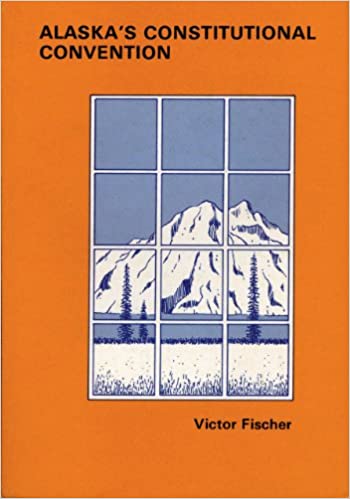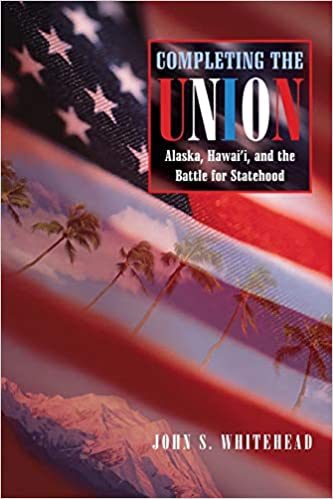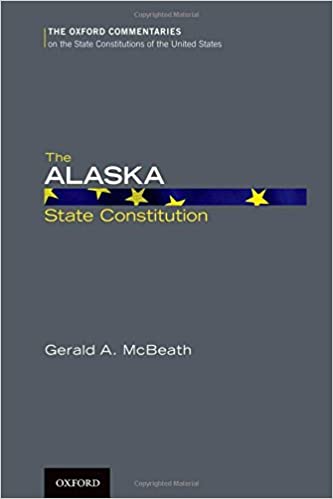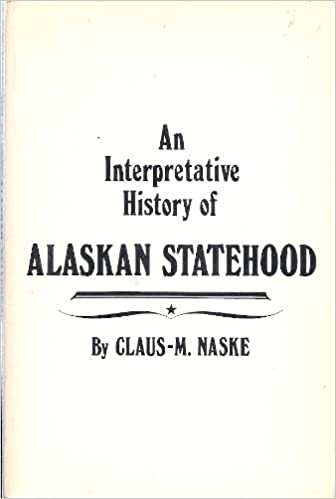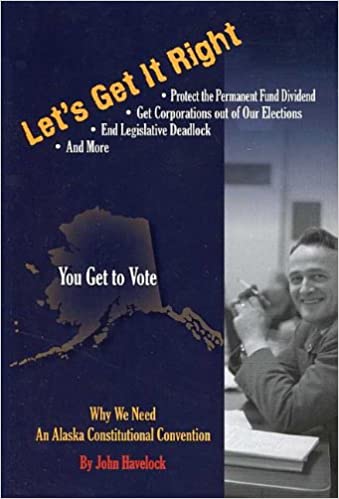Convention Calls
| Vote Date* |
Yes # |
No # |
Yes % |
No % |
Called? |
| 1970 | 34,911 | 34,472 | 50.31% | 49.68% | Yes* |
| 1972 | 29,192 | 55,389 | 34.51% | 65.49% | No |
| 1982 | 63,816 | 108,319 | 37.07% | 62.93% | No |
| 1992 | 84,929 | 142,735 | 37.30% | 62.70% | No |
| 2002 | 60,217 | 152,120 | 28.36% | 71.64% | No |
| 2012 | 90,079 | 179,567 | 33.41% | 66.59% | No |
*Opponents sued to disqualify the election results and won. See Boucher v. Bomhoff, 495 P.24 77 (1972). Key excerpts copied below. See the separate web page discussing that case and how convention opponents have used it.
Primary Documents
Alaska Constitutional Convention from Nov. 8, 1955 to Feb. 6, 1956
1955 Enabling Act, approved March 19, 1955.
Constitutional Convention Proceedings, from Nov. 8, 1955 to Feb. 6, 1956. An earlier version can be found here.
University of Alaska constitutional convention materials, part of its Creating Alaska – The Origins of the 49th State project. In 2017, the University of Alaska Fairbank’s Centennial Committee put together a separate and scaled down website.
Alaska Constitutional Research, Alaska State Court Law Librar Resources, Nov. 2011.
Sterling, W. Clinton, Sources of Alaska Legal History: An Annotated Bibliography, Part I, 110 Law Libr. J. 333, Summer, 2018, pp. 7-9.
Alaska. Constitutional Convention (1955-1956). Social Networks and Archival Context.
Alaska Constitutional Convention (1955-1956), WorldCat.
Pro & Con Statements: State of Alaska Official Election Pamphlet
2022 Referendum (Nov. 8, 2022), Ballot Measure #1. Mailed to all Alaskan voters on Oct. 10, 2022.
2012 Referendum (Nov. 6, 2012), Ballot Measure #1.
2002 Referendum (Nov. 5, 2002), Ballot Measure #1.
1992 Referendum (Nov. 1992), Ballot Measure #1.
Note: Despite the header “Ballot Measure #1,” local ballot measures come before this ballot measure in the layout of the ballots.
General Background on Alaska’s Official Election Pamphlet
From the State of Alaska Official Election Pamphlet Website, Accessed January 24, 2022:
- The Official Election Pamphlet (OEP) is prepared to assist Alaskan voters in making informed choices prior to Election Day.
- The OEP includes biographical statements prepared by candidates who elected to participate in the OEP. The text of the biographical statements is provided and paid for by the candidate in accordance with AS 15.58.030 and 6AAC 25.690. Views expressed in the biographical statements are from the candidate and not endorsed by the Division of Elections.
- The OEP also contains information about any ballot measures appearing on the ballot, how to vote, voting locations, absentee voting and voter rights, etc.
- The OEP is mailed to every voter household no later than 22 days prior to Election Day.
- The OEP is available online in a PDF format no later than 22 days prior to Election Day in English, Spanish, Tagalog and targeted Alaska Native Languages.
Key Dates Regarding Statehood Constitutional Convention
| Description | Date |
| Launch of Operation Statehood Constitutional Study Committee | Feb. 1954 |
| Enabling Act becomes effective | March 19, 1955 |
| Petitions due for candidates seeking to be placed on the ballot | May 10, 1955 |
| Alaska Statehood Committee hires Chicago-based non-profit PAS to provide research and consulting services for the upcoming convention | June 1955* |
| Delegate election | Sept. 13, 1955 |
| Convention begins | Nov. 8, 1955 |
| Convention adjourns | Feb. 6, 1956 |
| Proposed constitution ratified | April 24, 1956 |
| U.S. House approves Alaskan statehood | May 28, 1958 |
| U.S. Senate approves Alaskan statehood | June 30, 1958 |
| Alaska Statehood Act becomes law | July 7, 1958 |
| New constitution takes effect | Jan. 2, 1959 |
| Proceedings of the convention are published | 1965** |
———————————————————————————-
* Four PAS consultants drafted documents in preparation for the convention and then another set of consultants served as staff support for the convention during the convention. Convention delegates were banned from mentioning consultant names during public convention proceedings and consultants were banned from speaking up during any public hearing or to the press.
** There were no committee transcripts. Committees also often failed to provide reasons for their proposals. Committee of the Whole transcripts were not created until the latter part of the convention.
Key Statistics Regarding Constitutional Convention Delegates
Degree of Competition
# of candidates: 171
# elected: 55
% of candidates elected: 32.2%
Lowest number of votes for a candidate to win: 49*
Delegate districts
# of total delegates: 55**
# elected from at-large districts: 7
# elected from local districts: 48
# of local districts: 22******
Incumbent Legislators
# candidates for delegate: 14***
# elected: 9#
% elected vs. total delegates: 16.4%
# A key distinction is incumbent delegates who are 1) retiring when after being elected a convention delegate, or 2) seeking re-election. The former don’t present a conflict of interet (a violation of the ban on plural office holding), just as legislators are allowed to serve in the executive branch after leaving the legislative branch. Unfortunately, Alaska’s readily available data on incumbent legislators running for convention delegates doesn’t distinguish between these two very different incentive structures.
Alaskan Minorities
# natives elected: 1
% natives elected vs. total delegates: 1.8%
% natives in state vs. at convention: 15.0%****
# caucasians elected: 54
% caucasians elected vs. total delegates: 98.2%
% natives in state vs. at convention: 15.0%****
Lawyers
# elected: 13
% elected vs. total delegates: 23.6%
Votes
Final Vote for the Proposed Constitution: 54 yes; 1 no*****
———————————————————————————-
* Thomas C. Harris in the Valdez district
** The number 55 was chosen because that was the number of delegates to the U.S. constitutional convention in 1787.
*** A federal district court ruled that incumbent legislators could not run as convention delegates based on the Alaska Organic Act passed by Congress. Plural office holding is generally either unconstitutional or frowned upon in a constitutional system based on checks & balances. The incumbents objected and Congress changed the law to enable them to run.
**** Based on 2019, not 1955 data. Population in 1955 was 222,000. Native population in 1955 was unknown. Population in 2019 was 731,545. Native population in 2019 was 109,577 (15.0% of total population). As a point of contrast, Hawaii’s recent statehood constitutional convention had 63 delegates of which 27 were Caucasian, 19 of Japanese ancestry, five of Chinese ancestry, and 12 (19.0% of total delegates) of at least partly native/Hawaiian ancestry,
***** The delegate opposed to the proposed constitution resigned just before the final vote.
****** Some local districts were multi-member districts.
The 49th State: Creating Alaska
J.H. Snider Comment: For a TV documentary, the 49th State does a good job describing Alaska’s statehood constitutional convention. But it is also a typical state constitutional convention hagiography: it shows what a great job the last state constitutional convention did in creating the current constitution, which is therefore worth reverence. This type of hagiographic constitutional convention messaging about the past is what state legislatures like to fund, whether it is publicly funded museum exhibits, K12 public school curricula, or other types of publicly funded programming. The purpose is to enhance the democratic legitimacy of the current government, not to enhance the democratic legitimacy of the state constitutional convention process. The U.S. government, via the U.S. General Services Administration, provided funding for this documentary. A Who’s Who of Alaska’s political leaders supported this documentary.
Unfortunately, YouTube requires the viewer to watch an ad before being able to view the documentary.
University of Alaska Summary: The 49th Star was created to recognize the 50th anniversary of Alaska’s constitutional convention. The hour-long film chronicles the road to statehood and the constitutional convention and includes interviews with convention participants, historical photographs and commentary by contemporary historians. The documentary was part of the statewide Creating Alaska project, which has worked to commemorate the 50th anniversary of the creation and signing of Alaska’s constitution.
YouTube Caption: In November of 1955, a dedicated group of Alaskans gathered in Fairbanks to shape the future. The 49th Star chronicles a great story of American democracy – an account of 55 people who assembled in sub-zero temperatures to write a state constitution widely considered one of the best ever written and a pivotal achievement as Alaska continued its journey to statehood. ©KUAC 2006
Alaska Statehood Pioneers: In Their Own Words
Alaska Statehood Pioneers: In Their Own Words, KTOO, Jan. 14, 2013.
KTOO Summary: Learn about the early days of a young state. Hear the stories of people who worked toward Alaska statehood and participated in the Alaska constitutional convention… in their own words. This ten-part series is a production of 360 North. Funding was provided by the Alaska Humanities Forum, the National Endowment for the Humanities and the Alaska Committee.
J.H. Snider Comment: This eight episode series is long. The first episode, The Constitutional Convention and Statehood, is a manageable 57 minutes and focused on the constitutional convention. Nice interviews with a handful of constitutional convention participants.
Celebration of the 50th Anniversary of Montana’s Constitutional Convention
J.H. Snider Comment: For another hagiographic approach to its constitutional history, see Montana; for example, see Montana State University to host celebration of 1972 Constitutional Convention, Montana Free Press, Jan. 27, 2022. Having said that, there is merit in Montana’s claims, and Alaska might learn something by studying Montana’s 1972 Constitution and Constitutional Convention.
1975 Book on Alaska’s Statehood Constitutional Convention
Fischer, Victor, Alaska’s Constitutional Convention, University of Alaska Press, 1975.
Book Summary: In 1956, delegates gathered at the University of Alaska in Fairbanks to write a constitution for what became the forty-ninth state of the union. They produced a document that many have said was more distinctly appropriate to its time and place than any other state constitution. Victor Fischer, one of the delegates, describes this historic event.
J.H. Snider Comment: This book is generally considered one of the two most authoritative accounts of Alaska’s statehood constitutional convention. It is well written and deserves that reputation. But it also has some flaws. As is typical of this genre, it is hagiographic in tone, especially in regard to the Constitution’s framers. Consistent with that tone, it has almost nothing to say about the politics of the convention delegate races. How, for example, did the public choose 55 delegates from among 171 candidates? This is a crucial omission, partly because debates over future conventions largely center on the delegate election process. Similarly, we are told little about how much of the constitution was derived from the National Municipal League’s Model Constitution, which was also influential in Hawaii’s near simultaneous constitution making process. John Bebout, one of the convention’s most influential consultants, was a high ranking officer in the National Municipal League. The focus is too much on Alaskans’ superhuman framers, thus contributing to the endemic Madonna-prostitute theory of constitution making, where past constitution makers are presented as giving birth via immaculate conception and prospective future ones giving birth via special interests and incumbent legislators.
Despite such a critique, it must be acknowledged that Alaska’s framers were indeed remarkably independent of such forces. They were also remarkably humble, willing to hire expert outsiders from Chicago and elsewhere and then willing to listen to them. Sure, those experts had biases, like advocacy for the National Municipal League’s Model Constitution. But their biases were transparent, as evidenced by prior publications. Normally, giving outside experts such power is disparaged, not only because the delegates are confident they know what is best but also because legislators and special interests loudly decry any influence by outsiders, which in practice seems to mean anyone else but themselves.
2004 Book Comparing Alaska’s and Hawaii’s Statehood, including Constitutional Convention, Experiences
Whitehead, John, Completing the Union: Alaska, Hawai’i, and the Battle for Statehood, University of New Mexico Press, 2004.
Book Summary: As late as mid-1941 the two territories of Alaska and Hawai’i were little known by most Americans. Alaska was seen as a frozen wasteland and Hawai’i, an exotic outpost in the mid-Pacific with a multi-racial, particularly Asian, population. The bombing of Pearl Harbor in late 1941 and the capture of two Aleutian Islands in 1942 made the two territories central theaters of World War II. Thousands of Americans came to know Alaska and Hawai’i as never before.
Once the war ended both territories hoped that statehood would be their reward for such loyal wartime service. Their strategic locations pointed to an increased national involvement in the Pacific and Asia. The 49th and 50th states would eventually be admitted, but it took thirteen years, from 1946 to 1959, to do it. The long delay was caused by many of the events of the Cold War. Both territories became enmeshed in the national politics of anti-communism, radical labor movements, and Arctic policy to resist a Soviet air attack across the polar North. A cadre of statehood supporters emerged to make their case to the nation, including the young Daniel Inouye of Hawai’i and Ted Stevens of Alaska, both of whom would become two of the most powerful senators in Congress.
J.H. Snider Comment: The best single chapter summary of Alaska’s constitutional convention. One set of details I especially liked was its description of how outsiders helped craft Alaska’s constitution and then win it statehood. Such acknowledgements are usually missing from officially sanctioned state constitutional convention accounts.
2011 Reference Book on The Alaska State Constitution
McBeath, Gerald, The Alaska State Constitution, Oxford University Press, 2011.
Book Summary: This book provides a brief overview of Alaska’s constitutional history followed by an in-depth, section-by-section analysis of the entire constitution.
J.H. Snider Comment: The strength of this expensive legal reference book is its section-by-section overview, not the historical section. For a brief overview of Alaska’s 1955-6 constitutional convention, the book is fine. But for detail, it cannot compare with the two sources cited above. It does provide a brief summary of constitutional amendments subsequent to the statehood convention. But this book is a reprint of a book originally published in 1997, so even that summary is some 25 years out of date.
1973 Book Alaska’s Statehood Movement
Naske, Clause-M., An interpretative history of Alaskan statehood, Alaska Northwest Pub. Co, 1973.
Book Summary: This book includes a chapter on the 1955-6 constitutional convention.
J.H. Snider Comment: A good single chapter summary of the 1955-6 convention. But what makes the book really shine is its single chapter on special interest opposition to both statehood and the constitutional convention. Despite appearances to the contrary, the political logic of special interest opposition to the convention then and now is essentially the same: special interest groups who benefit from the status quo and their, by definition, disproportionate influence over the legislature will always be opposed to holding a convention regardless of the claimed differences in circumstances.
2012 Book Arguing for an Alaskan Constitutional Convention
Havelock, John, Let’s Get it Right: Why We Need an Alaska Constitutional Convention, Alaska Legal Publishing Company, 2012.
Book Summary: An Alaska Consitutional Convention? Improvements are essential to make Alaska government work. A convention can do what the legislature cannot or will not. The Right fears a Left take over; the Left fears the same from the Right. Havelock, a former Attorney General and Director of Legal Studies for the University believes: the Center will hold.
J.H. Snider Comment: The book is written by an authority on both the law and Alaska. But for a book arguing for a constitutional convention, the author knows remarkably little about the history, democratic function, and politics of this institution. The book’s lasting influence will not be scholarly. Instead, it may be practical, which was its intent. Of special political importance may be its linking of a proposed state constitutional convention with the future of the Permanent Fund Dividend, an explosive issue in the Alaska legislature where the legislature’s interest and public opinion may conflict, thus potentially creating a politically salient reason for Alaskans to call a constitutional convention.

